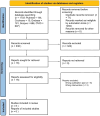Negative Pressure Wound Therapy with Instillation for Periprosthetic Infection after Breast Reconstruction: A Systematic Review
- PMID: 39507314
- PMCID: PMC11537567
- DOI: 10.1097/GOX.0000000000006267
Negative Pressure Wound Therapy with Instillation for Periprosthetic Infection after Breast Reconstruction: A Systematic Review
Abstract
Background: Periprosthetic infection after breast reconstruction is not uncommon and can result in loss of the implant pocket and negative patient outcomes. Management of these infections typically involves removal of the prosthesis, treatment with antibiotics, and delayed reconstruction upon infection resolution. The impact of adjunctive use of negative pressure wound therapy with instillation and dwell (NPWTi-d) on breast pocket salvage rates, time to implant reinsertion, and related outcomes was examined.
Methods: A systematic literature search using PubMed, Cochrane, OVID, Scopus, and Embase was conducted to identify peer-reviewed articles written in English and published between January 2004 and April 2023 that examined NPWTi-d use in the breast pocket with a history of periprosthetic infection after breast reconstruction.
Results: Of the 1703 publications, 6 studies met inclusion criteria, representing 115 patients and 122 breasts. The overall breast pocket salvage rate with NPWTi-d across studies was approximately 92%. In the 6 studies that included prosthesis type and radiation history, overall salvage rates were 97.8% (45 of 46) for pockets containing implants and 93.8% (15 of 16) for pockets containing tissue expanders. Salvage rates were 85.7% (12 of 14) and 91.7% (53 of 58) for irradiated and nonirradiated breasts, respectively. Mean time to implant reinsertion ranged from 2.3 to 10.3 days.
Conclusions: In this review, antibiotic therapy along with adjunctive use of NPWTi-d for periprosthetic infections after breast reconstructions was associated with high rates of breast pocket salvage and reduced time to implant reinsertion. Larger prospective and randomized trials are needed to better understand and optimize the effectiveness of NPWTi-d in this population.
Copyright © 2024 The Authors. Published by Wolters Kluwer Health, Inc. on behalf of The American Society of Plastic Surgeons.
Conflict of interest statement
Dr. Galiano is a consultant and receives funding from 3M/KCI. Drs. Collinsworth and Griffin are employees of Solventum. The other authors have no financial interest to declare in relation to the content of this article. Disclosure statements are at the end of this article, following the correspondence information.
Figures
References
-
- American Society of Plastic Surgeons. Plastic surgery statistics report 2020. Available at https://www.plasticsurgery.org/documents/News/Statistics/2020/plastic-su....
-
- Alderman AK, Wilkins EG, Kim HM, et al. . Complications in postmastectomy breast reconstruction: two-year results of the Michigan Breast Reconstruction Outcome Study. Plast Reconstr Surg. 2002;109:2265–2274. - PubMed
-
- Salzberg CA, Ashikari AY, Koch RM, et al. . An 8-year experience of direct-to-implant immediate breast reconstruction using human acellular dermal matrix (AlloDerm). Plast Reconstr Surg. 2011;127:514–524. - PubMed
-
- Spear SL, Howard MA, Boehmler JH, et al. . The infected or exposed breast implant: management and treatment strategies. Plast Reconstr Surg. 2004;113:1634–1644. - PubMed
LinkOut - more resources
Full Text Sources
Miscellaneous

